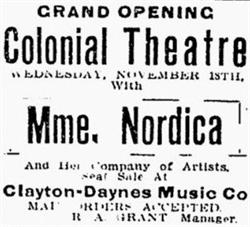
|
|
Colonial Theatre (Pantages Theatre, Loew's State Theatre, Victory Theatre) 48 East 300 South Salt Lake City, Utah (Before 1909 - 1942) |
The Colonial Theatre was a “popular price“ playhouse,[1] presenting standard plays by traveling companies associated with the Northwestern Theatrical Association. The $150,000 theater was built by the Auerbach brothers, who later built the Centre Theatre. The architect was E. W. Houghton of Seattle, Washington.[2]
The opening ceremony for the Colonial Theatre was held on 18 November 1908. Speeches were made by Governor Cutler; Mayor Bransford; Calvin Heilig, president of the Northwestern Theatrical Association; and John Cort, secretary. The main attraction was a performance by Madame Nordica, world-famous prima dona. Among the boxholders were Samuel Newhouse, G. S. Holmes, J. W. Houston, and J. A. Greenewald.[3]
The interior of the Colonial Theatre was decorated with ivory and gold, with green sidewalls, carpets and draperies. A modern feature of the theater was that every light was hidden, their soft glow being shed through frosted glass. The three-story theater had a seating capacity of 1936, with 644 on the main floor, 665 in the balcony, 555 in the top gallery, and 72 in box seats.[3]
The Colonial was built on property owned by the Auerbach brothers. The theater was 110 feet wide, the entire width of the lot, and 290 feet deep. Stores occupied the portions of the ground floor not used by the lobby of the playhouse. It was thought that the upper two floors might be used for bachelor's apartments. Beneath the theater was a basement rathskeller.[2]
The Colonial Theatre was known briefly as the Pantages Theatre, probably before 1919. By 1926 the theater had been renamed the Victory Theatre.[4]
The Utah-made film All Faces West, with a theme song written by Roland Parry, premiered at the Victory Theater in March 1929.[5]
The Victory Theatre was destroyed by fire in 1942, while it was being operated by Intermountain Theatres.[6] The buidling was demolished in 1943.
1. "Auerbach Theatre Plans", Salt Lake Herald, 30 June 1908
2. "Two Theatres to be Erected", Salt Lake Herald, 6 June 1908, page 12
3. "Grant Will Open the New Colonial Theater", Ogden Standard Examiner, 18 November 1908, page 1
4. Polk’s Salt City Directory, 1930; Polk’s Utah Gazetteer and Business Directory, 1927-1928, 1930-1931
5. "Utah Filmmakers of the Silent Screen", by Richard Nelson, Utah Historical Quarterly, Volume 43, Number 1 (Winter 1975), listing as sources: Salt Lake Tribune, 2 March 1929; "Utah-Made Film Has Premier at Victory Theater," Salt Lake Tribune, 24 February 1929; "Utah Picture Holds Interest at Victory," Deseret News, 4 March 1929.
6. Salt Lake City Classified Business Directory, Summer 1926, Summer 1929, November 1942
